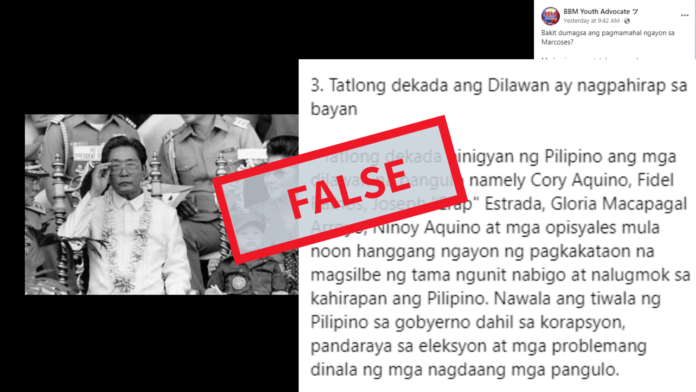The definitive ruling by the country’s highest court should be enough to settle the matter.
CLAIM: “Yellow” presidents failed to improve Filipinos’ lives over a period of three decades
RATING: False
The faulty narrative that the “Yellow” presidents that took over after the downfall of the Marcos regime in the 1986 EDSA People Power Revolution did nothing good for the country is a staple of pro-Marcos social media accounts. The apparent objective is to diminish the presidencies after Marcos while propping up the latter’s image and downplaying economic hardships and human rights violations during the Martial Law regime.
This remains a key talking point for the camp of presidential candidate Ferdinand “Bongbong” Marcos Jr. days before the May 9 elections, with the Facebook page “BBM Youth Advocate” falsely claiming that five “Yellow” presidents failed to improve Filipinos’ lives.
The May 6 post, which has been shared more than 400 times and commented upon more than 200 times, claimed:
“Tatlong dekada binigyan ng Pilipino ang mga dilawan na pangulo namely Cory Aquino, Fidel Ramos, Joseph ‘Erap’ Estrada, Gloria Macapagal Arroyo, Ninoy Aquino at mga opisyales mula noon hanggang ngayon ng pagkakataon na magsilbe ng tama ngunit nabigo at nalugmok sa kahirapan ang Pilipino.”
We have to break down the false claim into two: first, that five “Yellow” presidents followed ousted dictator Ferdinand Marcos Sr., Bongbong’s father and namesake; and second, that Filipinos’ lives did not improve over the three-decade period that these presidents were in power.
“Yellow” was the color of the 1986 presidential campaign of Corazon Aquino, as opposed to the Marcos camp’s red. The color was adopted by pro-Aquino parties, notably the Liberal Party that propelled her son, Benigno Aquino III, to the presidency in 2010.
On that basis, the “five presidents” claim is incorrect. After Corazon Aquino (1986-1992) and her anointed successor, Fidel Ramos (1992-1998), Joseph Estrada (1998-2001), Gloria Macapagal-Arroyo (2001-2010) and Benigno “Noynoy” Aquino III (2010-2016) followed. The page erred in saying that “Ninoy,” Noynoy’s father, became president; the ex-senator was assassinated at the Manila airport in 1983.
Estrada ran under his own Pwersa ng Masang Pilipino party, whose color is orange. As mayor of San Juan prior to the EDSA revolt, Estrada was firmly aligned with the Marcos regime.
Arroyo was originally aligned with the Aquino camp when she was installed to the presidency by the 2001 EDSA “People Power 2” uprising that ousted Estrada. But the Liberal Party withdrew support from her in 2005 after allegations emerged that she rigged the 2004 presidential election. Corazon Aquino called on Arroyo to resign in 2005 and 2008 at the height of scandals surrounding her presidency.
It should be noted that Arroyo has since aligned with President Rodrigo Duterte and is now backing the Marcos presidential campaign.
The second part of the claim supports the false narrative of the Marcos regime as the “Golden Age” of the Philippines. According to the Martial Law Museum, 6 out of 10 Filipinos were poor by the end of the late dictator’s rule, as prices soared and wages declined. About 4 in 10 were considered poor when Marcos Sr. took office.
In 2015, before Duterte took office, poverty incidence stood at 23.3%, or roughly 1 in 5 Filipinos. The latest official estimates, for the first half of 2021, placed the magnitude of poverty at 23.7% of the population, up from 21.1% in 2018, as a result of the economic downturn precipitated by the Covid-19 pandemic.
The poverty situation is still a problem, but to say that nothing changed since the Marcos regime is pure propaganda, designed to prop up the Marcoses and help them return to power.


0 Comments